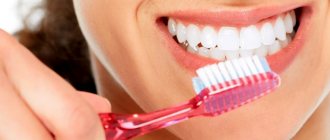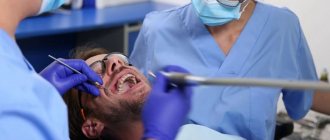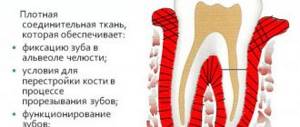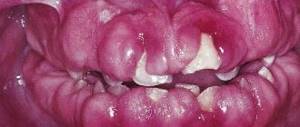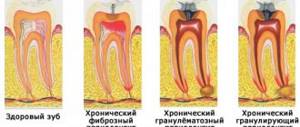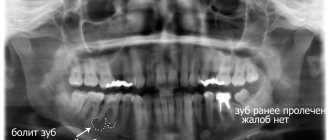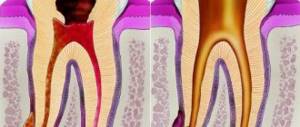Modern dental treatment
Dental treatment of teeth is a set of measures aimed at eliminating the inflammatory process and restoring chewing functions. The most common disease is, of course, caries and its complications. The timing of dental treatment directly depends on the stage of development of the disease. Thus, installing a dental crown or implanting several teeth will take different times, depending on the number of specialist appointments. It is worth noting that regular preventive examinations allow you to notice pathologies at an early stage, allowing for dental treatment without extraction and significantly simplifying it.
If a patient comes to the clinic with acute pain, the task becomes much more complicated. Therefore, every dentist will tell you that the best dental treatment is prevention.
Photos before and after dental treatment
Photos Before and After treatment of chewing teeth.
Photos Before and After treatment of front teeth.
No one has ever died from a bad tooth
Reality: Infection coming from a diseased tooth (odontogenic infection) is one of the most dangerous. A diseased tooth is a source of pathogenic environment in the body. Numerous colonies of microorganisms live and multiply in the mouth, some of them quite aggressive. From a “neglected” diseased tooth, microbes can travel throughout the body, both independently and by causing allergization of the body, which leads to a decrease in immunity. In addition, ulcers on the roots with a decrease in immunity can lead to the development of serious complications (abscesses, phlegmon, osteomyelitis, etc.), and sometimes cause conditions incompatible with life.
Fact: Scientists have proven that the presence of multiple chronic foci of infection in untreated teeth in pregnant women leads to miscarriage and low fetal weight during childbirth.
What to do?
At least 1-2 times a year, undergo examination and professional hygiene at the dentist, which will help identify and effectively eliminate pathology in the initial stages of development.
Fact: Expenses of Russian residents, according to data at the beginning of the century, on certain types of goods and services (per year): - for vodka, beer, cigarettes - $12 billion, - for medicines - $2.2 billion, - for dental care – $600 million
Endodontic dental treatment
What is endodontic dental treatment? This is a procedure aimed at treating root canals, usually using a microscope. If you ignore the symptoms of caries for a long time, pulpitis, periodontitis and other complications develop. Endodontic treatment of teeth under a microscope will help eliminate acute pain and relieve inflammation. The help of an endodontist is indispensable when there is a suspicion of a dental cyst or granuloma. Often, after canal treatment, complications arise due to poor quality treatment or stuck pieces of broken instruments. In such difficult cases, they also resort to endodontic treatment of the tooth canal under a microscope.
Is it possible to strengthen teeth with folk remedies?
Folk remedies do not replace professional treatment, but complement therapy well.
- Infusion of linden flowers (dry) and soda. The infusion is carried out for 5 hours in cold water, used for rinsing, and has a preventive effect.
- A mixture of honey and salt is rubbed into the gums for periodontal disease.
- Corn porridge for breakfast - a composition rich in valuable components will help maintain dental health.
- Honey and rose oil as a teeth lubricant. Course – 10 days. After a break, you can repeat the effect.
- A decoction of a mixture of medicinal herbs (crushed) is used to rinse teeth.
- Cleaning teeth with propolis.
- Rinse with sea salt solution every night. After the procedure, you should not eat.
Treatment without drilling
Dental treatment without drilling involves the use of minimally invasive procedures. Some of them have been mentioned above. In particular, lasers are actively used to eliminate caries. This type of dental treatment is performed for adults and children. Among the main advantages is a reduced risk of any infection, since contact of equipment with organs and tissues of the oral cavity is eliminated.
Also, dental treatment without a drill can be performed using the chemical-mechanical method. A special preparation is applied to the area of the tooth affected by caries. It contains sodium hypochlorite and amino acids. Next, the specialist treats the affected area using special tools. Since only dead tissue is removed, the filling occupies a much smaller area, and it is also possible to preserve healthy areas as much as possible.
Another interesting technique was developed by German specialists. It is based on the bactericidal properties of ozone and is often used in pediatric dentistry. The gas used to treat teeth completely destroys microorganisms that cause caries.
The latest non-invasive methods
Before dental treatment, a specialist determines the degree of destruction of enamel, hard tooth tissue and dentin. In advanced cases, a granuloma forms around the root, which may subsequently increase in size. Modern methods of dental treatment make it possible to successfully combat the first signs of caries without the use of a drill. Among them:
- laser dental treatment;
- application of chemical-mechanical techniques;
- fluoridation – treatment of teeth with calcium;
- application of the air-kinetic method;
- ozone therapy.
Treatment of a tooth under a crown
After some time has passed after the installation of the prosthesis, subsidence of the gums and exposure of the neck of the tooth are often observed. All this contributes to the development of caries, and therefore pulpitis, periodontitis and other unpleasant diseases can appear even when the tooth is covered with a crown. Only a specialist can identify the problem and treat the tooth under the crown. If a disease is detected, the structure may need to be removed.
It is also the cause of problems - errors in the manufacture of the prosthesis: if the crown does not fit tightly around the neck of the tooth, bacteria can get under it. The specialist immediately removes such structures and carries out dental treatment. The crowns will subsequently be replaced, which will preserve the teeth and prevent the development of more serious diseases.
About the causes of caries
Caries is the most common dental disease - bone tissue is destroyed and becomes soft, cavities form. The disease is a consequence of an unbalanced diet. Caries causes:
- Deficiency of phosphorus, potassium and protein;
- Excess sugar;
- Pathogenic microbes that multiply quickly in an acidic environment.
- Don't give germs a chance:
- Sweet foods should not be consumed frequently;
- You need to brush your teeth and gums properly;
- Rinse your mouth regularly;
- There should be no pieces of food left between the teeth.
Anesthesia
Conventional local anesthesia is performed very often today. Patients with increased sensitivity of soft tissues and children can first be given topical anesthesia. Also in dentistry, painkillers are used for dental treatment. The type of drug and its dosage are selected individually - it all depends on both the patient’s health condition and the clinical situation. For example, pediatric dentists often treat teeth with nitrogen. Laughing gas causes a feeling of mild euphoria and is not hazardous to health. The patient relaxes, and the doctor can calmly perform all the necessary manipulations. But general anesthesia in dentistry is used only in the most extreme cases.
Anesthesia after dental treatment can last up to 3 – 4 hours. Everything here is very individual and depends on how much anesthetic was used.
Features of treatment of anterior teeth
Treatment of anterior teeth is associated with some difficulties. A characteristic feature of the incisors is their smaller size compared to other teeth. The work that a dentist has to do is truly jewelry. Only an experienced specialist can achieve a high degree of aesthetics.
In the process of treating and restoring the shape of a diseased tooth, a filling can be performed using light-curing polymer materials or veneers. Their shade is selected taking into account the color of the enamel of the patient’s healthy teeth.
The last resort is the installation of crowns. This method is justified only if the tooth is severely damaged. Treatment of lower teeth in the frontal zone is performed using similar methods and techniques.
Dentists and other specialists
- The very first dentist we know lived in Egypt more than 5,000 years ago. His name was Hesi-Re.
- Ancient Greek healers advised using pumice, talc, alabaster, coral powder or iron rust as toothpaste.
- The ancient Romans used impressive dental technology for their time - they placed gold crowns on their teeth.
- In Rus', sales people strengthened teeth with a medicine made from crushed deer antler and wine, whitened them with gunpowder or salt, and recommended cleaning them with chicken bones, a prototype of toothpicks.
- Due to the lack of professional dentists, until around the 19th century in Europe, teeth were treated mainly by representatives of other professions: bathhouse attendants, jewelers, barbers and even engravers.
“The filling will cost you two thousand rubles.” - “In 10 minutes of work?!” - “If you want, I will work slower.”
Reason to see a doctor: symptoms that cannot be ignored
If a tooth hurts, treatment should never be delayed. Any delay is fraught with serious problems not only for the oral cavity, but also for the whole body. The sooner the source of infection is identified, the easier and faster dental treatment can be performed in the clinic. Symptoms that indicate serious problems:
- acute throbbing pain in the tooth;
- significant increase in sensitivity;
- bad breath during regular hygiene;
- bleeding and swelling of the gums;
- tooth mobility;
- difficulty opening the mouth;
- the appearance of a defect on a tooth, an area with uneven edges and pigmentation.
If a tooth falls out, you can do just fine without it.
Reality: Each tooth in our wide smile is a link in the dental chain. Each group of teeth performs its own function: some bite off food, others chew it. When a tooth is removed or falls out, the shape of the teeth and jaws changes. The teeth adjacent to the missing one begin to shift and fill the vacated space, which can subsequently cause difficulties with prosthetics.
Fact: Significant tooth loss leads to eating more monotonous and less balanced food, a lack of vitamins and microelements, which can affect brain activity.
What to do?
Lost teeth need to be restored, which can be done in various ways. The options of choice are restorative orthopedic structures supported either by implants or by natural teeth. Fact: The fewer natural teeth a person has, the higher the risk of developing coronary heart disease and heart attack. People with fewer than 10 natural teeth are seven times more likely to die from a heart attack than those with more than 25 teeth.
Stages of dental treatment
Despite the fact that modern methods involve virtually painless dental treatment, fillings and other procedures, many patients appear in the doctor’s office with acute pain and a whole “bouquet” of oral diseases. Treatment usually includes the following steps:
Diagnostics
A specialist examines the oral cavity, identifies problems and draws up a treatment plan. Additional examinations may be ordered. At the same stage, the doctor conducting the consultation discusses the cost of services with the patient and selects the most convenient time for an appointment.
Professional oral hygiene
It is advisable to begin dental treatment only after their surface is cleaned of hard and soft deposits.
Treatment
The process of treating caries involves removing the affected tissue. The procedure is performed using local anesthesia, and the treated area is isolated from the rest of the mouth. Rubber dam or cotton swabs can be used for these purposes.
Seals
Filling is carried out after cleaning the carious cavity. The final procedure is grinding the filling - this is necessary to eliminate the occurrence of discomfort during the process of chewing food.
How to prevent tooth loss
Preventing tooth loss is not so difficult; all you need to do is follow a few recommendations:
- Quitting smoking and alcohol.
- Normalization of diet, refusal of harmful foods, dyes, synthetic additives.
- Minimum sugar consumption or complete refusal of it.
- Avoiding sugary soda is the main enemy of healthy teeth.
- Maintaining hygiene means regularly brushing your teeth and rinsing with special solutions after meals.
- Regular professional cleaning of the oral cavity - removal of tartar and other deposits.
- If the immune system is weakened, take immunomodulators.
- Regular dental checkups.
If you have chronic diseases and other risk factors, you should pay increased attention to dental health and regularly visit a specialist. This will allow you to detect potential problems in time and eliminate them. But it is much simpler and cheaper than prosthetics.
Why does a tooth hurt after treatment and what to do in this case?
Aching pain after treatment occurs quite often. However, its causes may be different, which means that the doctor’s actions to eliminate it are required different. Let's look at the most popular:
- Very often, after treatment, the tooth reacts to mechanical stress when chewing food. As a rule, minor pain appears after treatment of deep caries. This is due to the fact that the filling puts pressure on the pulp. Over time, the pain will pass.
- It is not uncommon for a tooth to ache after treatment and due to an individual reaction to the doctor’s intervention. The pain may persist for several days.
- Acute pain after dental treatment cannot be ignored. You must immediately contact a specialist. Unpleasant pain may indicate that there is inflammation after dental treatment.
- If you are sensitive to irritants such as hot and cold drinks, sweet or sour foods, then there is a high probability that the overhanging edge of the filling will injure the periodontal tissue in the gum area. This phenomenon leads to tissue inflammation and exposure of the tooth root, which is extremely sensitive to any irritants. Therefore, be sure to contact the dental clinic if your tooth aches after recent manipulations. The treatment was most likely carried out poorly.
Periodontitis - forms, classification, photos
It is a consequence of pulp necrosis, which allows microorganisms to enter the hard and soft tissues of the jaw through the dental canal. The inflammatory process includes the peridontal ligament, cementum, root dentin together with the alveolar bone. Signs of periodontitis:
- the occurrence and intensification of pain when pressing on the tooth during the chewing process. There is a constant painful pulsation affecting half of the face;
- increased body temperature, feeling of weakness;
- swelling and tenderness of the gums in the affected area, as well as lymph nodes (mental and submandibular);
- discharge of pus from the root canal;
- facial asymmetry due to edema.
Consequences : lack of medical care leads to independent release of pus through the bones under the periosteum, as a result of which periodontitis becomes chronic.
Chronic periodontitis
A person may not be aware of the presence of the disease for a long time, since it occurs without the slightest symptoms. The reason to suspect the disease is the presence of a history of pain that was in the past, but gradually disappeared and does not remind of itself. A feature of chronic periodontitis is the melting of bone tissue around the affected tooth . Further development of the disease leads to loosening of the damaged tooth, as well as neighboring ones. Consequences: a common result is the loss of several teeth or granuloma .
Granuloma
It is a natural consequence of advanced periodontitis. The disease is marked by the spread of the inflammatory process, which is presented in the form of a small purulent nodule or sac in the area of the tooth root. Consequences: the infectious focus poses a serious danger to the body, as it acts as a catalyst for inflammation. At the initial stage, granulomas are characterized by practically asymptomatic progression. Severe pain gradually arises, which becomes more noticeable when pressing on the tooth or chewing solid food. Redness and swelling of the gums are noted, and tooth enamel becomes darker.
Root cyst
Lack of measures to treat granuloma leads to complications in the form of a root cyst. It forms at the top of the tooth root and is firmly attached to it. It looks like a round cavity located in the bone tissue, inside of which there is purulent contents. The root cyst grows slowly and imperceptibly, and therefore poses a significant danger. It can be visually determined only if it grows strongly, when protrusion of the bone is observed. Consequences: there is a possibility of the cyst growing into the maxillary sinus and nasal cavity. Displacement of teeth to the sides, as well as pathological fracture of the lower jaw.
Periostitis of the jaw bone, tooth
If treatment of root cysts and periodontitis was not carried out or was carried out in bad faith, then the likelihood of periostitis or inflammation of the periosteum sharply increases. The inflammatory process begins to emerge from the periodontal fissure and enters under the periosteum. Surgery is required, which involves making an incision in the mouth under anesthesia to release the pus. Consequences : failure to see a doctor in a timely manner carries the risk of an abscess.
Abscess
An abscess is a collection of purulent tissue in a confined space. The pus begins to put pressure on the root apex area, which leads to the tooth being pushed upward and possible destruction of the bone tissue in the affected area. If the abscess does not open for a long time, then the spread of pus to the periosteum, skin and mucous membrane begins. Consequences : severe and painful swelling occurs.
Phlegmon
It is considered one of the most dangerous forms of abscess. Cellulitis carries with it the risk of serious infection of the body, since infection and purulent accumulations from the swollen area enter the body. In fact, pus begins to spread throughout the surrounding tissues and can reach the neck and even the heart. The following symptoms are characteristic of phlegmon:
- swelling and tenderness of the soft tissue of the gums around the affected area;
- difficulty swallowing and opening the mouth;
- painful sensations behind the eyeball;
- deterioration of appetite and sleep;
- fever and weakness.
Consequences: the disease carries with it a significant risk of death! (we do not publish photos of phlegmon, copy and paste the word into a search engine to see the pictures).
Sinusitis
Inflammatory processes in the oral cavity (pulpitis, deep caries stage, cysts, periodontitis and others) aggravate the risk of single-gene sinusitis (sinusitis). It is caused by the penetration of infection from the affected tooth into the maxillary sinuses (we are mainly talking about infection in the upper molars and premolars, which are practically in contact with the maxillary sinuses). Initially, the infection enters only one maxillary sinus, then it spreads to the other. There is a possibility of getting into the sphenoid, frontal and other sinuses. Sinusitis manifests itself:
- severe headaches;
- swelling of the cheek;
- elevated temperature;
- thick mucous discharge of a purulent nature;
- pathological reaction to light.
If adequate treatment is not carried out in a timely manner, sinusitis can lead to the following consequences :
- transition to a chronic form;
- meningitis;
- sepsis, which is localized near the brain;
- purulent otitis;
- inflammation and swelling of nerve endings.
Tooth loss
Due to improper oral care and delays in seeking medical help, teeth decay and fall out. What are the consequences of losing teeth? Consequences :
- irreversible imbalance in the activity of the oral system. The absence of even one tooth disrupts the position of neighboring teeth; they do not hold so firmly in the gums, which can lead to their loss;
- a decrease in the efficiency of eating, as the degree of chewing and, accordingly, digestion of food deteriorates. A natural consequence is gastrointestinal diseases and metabolic disorders;
- curvature of the dentition, malocclusion, increased risk of diseases of the periodontal tissues;
- loss of aesthetic appeal (change in facial oval, sunken cheeks, visual unattractiveness due to missing teeth).
Bone atrophy
Atrophic processes in the maxillofacial region are a natural consequence of the absence of even one tooth. Its loss means the displacement of an entire row of teeth, a significant decrease in the volume of bone tissue. If atrophy is not stopped by building up bone tissue, then the lips and cheeks begin to “sink” into the oral cavity, and healthy teeth begin to move along the dentition due to loss of support. Consequences:
- the appearance of cosmetic facial defects (wrinkles, sunken lips, cheeks, etc.);
- deterioration of chewing function and the occurrence of gastrointestinal disorders;
- pathological changes in speech;
- displacement of the dentition, loss of healthy teeth.
Avoiding such unpleasant consequences is both easy and difficult. The main thing is to carefully observe oral hygiene and consult a dentist as soon as possible!
How much does dental treatment cost in Moscow?
Taking into account the fact that therapy involves an integrated approach, the total cost of dental services will consist of the costs of individual procedures. Approximate prices for dental treatment in Moscow are presented in the table below.
| Type of service | Price |
| Specialist consultation | from 500 rubles, but most often it is free |
| Professional hygiene of the entire oral cavity | from 3,000 rubles |
| Treatment of pulpitis (depending on the number of channels) | from 4,000 rubles |
| Filling using light-curing polymer material | from 3,000 rubles |
| Aesthetic restoration of anterior teeth | from 5,000 rubles |
Assorted teeth
- If you are right-handed, it means that the right side of your jaw is dominant, and it is with it that you most often chew everything.
- We see only 1/3 of each tooth, 2/3 of the teeth are under the gums.
- No person has the same teeth. Each person's teeth are unique, like fingerprints.
- Some people believe that bones are the strongest part of our body. In fact, the tooth enamel on the outside of your teeth is stronger.
- Dental plaque contains on average 300 types of bacteria.
- The body produces more than 25,000 liters of saliva in a lifetime - enough to fill two swimming pools. Saliva aids digestion and protects teeth from bacteria in the mouth.
- Many dental problems are associated with heart disease, osteoporosis (low bone mass) and diabetes.
“If your teeth are like pearls, they let you wear them.” Gennady Malkin, hockey player


